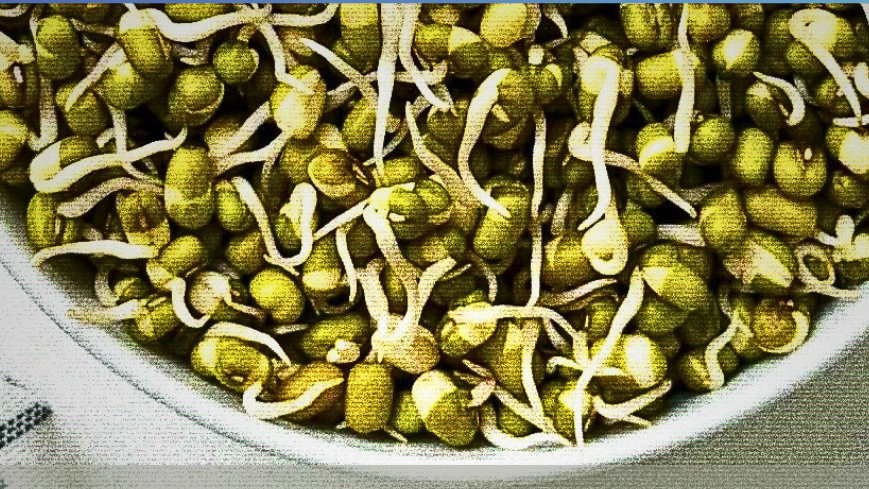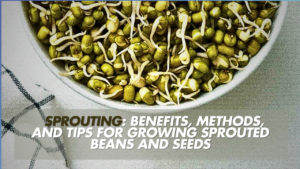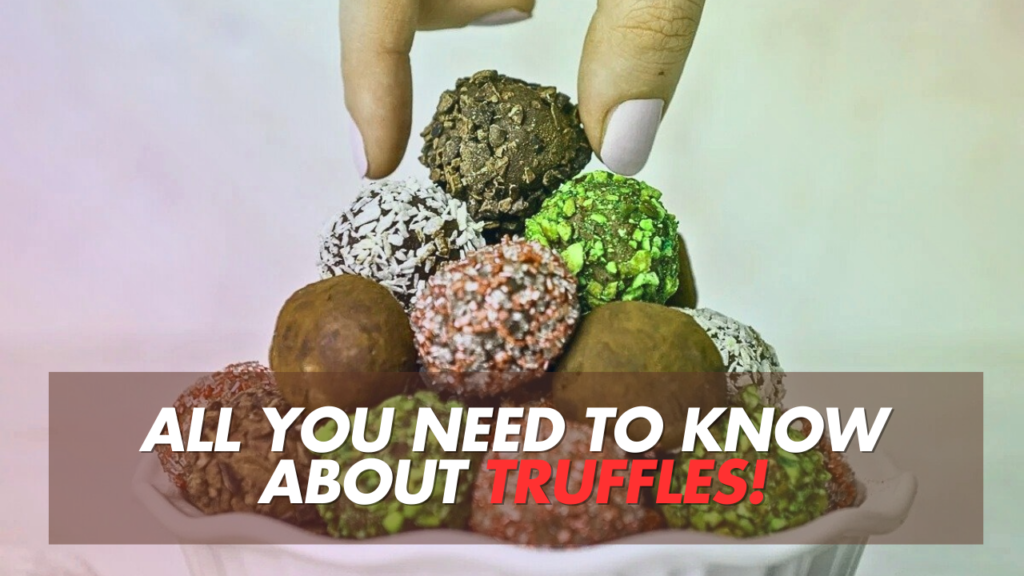Table of Contents
Introduction
The process of sprouting is a natural transformation that creates live, nutrient-rich crops from dormant seeds, grains, and legumes. Because of its amazing health advantages, ease of use, and adaptability, this age-old technique has become more and more popular in modern times. Whether you’re a home gardener, health-conscious person, or foodie, sprouting is an easy and satisfying method to improve your nutrition.
The physics of sprouting, the advantages of sprouted beans and seeds, detailed instructions for sprouting at home, and helpful advice to guarantee success are all covered in this extensive book. You’ll have all the information you need to begin sprouting like an expert and take advantage of the practice’s gastronomic and nutritional advantages by the end.
What is Sprouting?
The process of reviving seeds, grains, or legumes to bring forth their latent potential is known as sprouting. Soaking seeds in water and letting them develop causes biochemical changes that boost their nutritional content, activate enzymes, and break down anti-nutrients. Through this process, tough, dry seeds become soft, palatable sprouts that are more nutrient-dense and simpler to digest.
Common examples of sprouted foods include:
- Sprouted Beans: Mung beans, lentils, chickpeas, and adzuki beans.
- Sprouting Seeds: Alfalfa, broccoli, radish, clover, and fenugreek.
- Sprouted Grains: Quinoa, buckwheat, and wheat berries.
Sprouting is not only a culinary technique but also a way to maximize the nutritional value of your food.
Why Sprout? The Benefits of Sprouted Beans and Seeds

Sprouting offers a wide range of health benefits, making it a valuable addition to any diet. Here’s a detailed look at why sprouted beans and seeds are so beneficial:
1. Enhanced Nutrient Profile
During sprouting, seeds undergo metabolic changes that increase their nutrient content. For example:
- Vitamins: Sprouting boosts levels of vitamin C, B vitamins (especially folate), and vitamin K.
- Minerals: The process reduces anti-nutrients like phytic acid, making minerals like iron, zinc, and calcium more bioavailable.
- Antioxidants: Sprouts are rich in antioxidants, which help combat oxidative stress and inflammation.
2. Improved Digestibility
Sprouting breaks down complex carbohydrates and proteins into simpler forms, making them easier to digest. It also reduces anti-nutrients like phytic acid and lectins, which can interfere with nutrient absorption and cause digestive discomfort.
3. Rich in Enzymes
Sprouted beans and seeds are packed with enzymes that aid digestion and support metabolic processes. These enzymes help your body break down food more efficiently, reducing bloating and improving nutrient absorption.
4. Eco-Friendly and Cost-Effective
Sprouting at home requires minimal resources—just seeds, water, and a container. It’s an affordable way to add fresh, organic produce to your diet without the need for soil, sunlight, or gardening space.
5. Versatile Culinary Uses
Sprouted beans and seeds can be used in a variety of dishes, adding texture, flavor, and nutrition. They’re perfect for salads, sandwiches, smoothies, stir-fries, and more.
6. Increased Protein Availability
During sprouting, proteins in seeds and legumes become more bioavailable, enhancing muscle growth and repair. This is particularly beneficial for vegetarians and vegans looking for high-quality plant-based protein sources.
7. Lower Antinutrients
Seeds and legumes naturally contain antinutrients that reduce nutrient absorption. Sprouting neutralizes these compounds, making the nutrients more accessible to the body.
How to Sprout Seeds and Beans at Home: A Step-by-Step Guide
Sprouting is a simple process that requires minimal equipment and effort. Here’s a detailed, step-by-step guide to help you get started:
Step 1: Choose Your Seeds for Sprouting
Not all seeds are suitable for sprouting. Look for high-quality, organic seeds specifically labeled for sprouting. Popular options include:
- Sprouted Beans: Mung beans, lentils, chickpeas, and adzuki beans.
- Sprouting Seeds: Alfalfa, broccoli, radish, clover, and fenugreek.
- Sprouted Grains: Quinoa, buckwheat, and wheat berries.
Avoid seeds treated with chemicals or pesticides, as they may not sprout properly and could pose health risks.
Step 2: Soak the Seeds
- Rinse the seeds thoroughly under cool water to remove any debris or dust.
- Place the seeds in a clean jar or sprouting container.
- Add enough water to cover the seeds completely.
- Let the seeds soak for 8-12 hours (or overnight). Soaking softens the seed coat and initiates the germination process.
Step 3: Drain and Rinse
- After soaking, drain the water using a fine mesh strainer or a sprouting lid.
- Rinse the seeds with fresh water to remove any residual anti-nutrients and keep them moist.
Step 4: Allow to Germinate
- Place the seeds in a well-ventilated area away from direct sunlight.
- Rinse and drain the seeds 2-3 times a day to prevent mold and maintain moisture.
- Continue this process for 3-7 days, depending on the type of seed and desired sprout length.
Step 5: Harvest Your Sprouts
Once the sprouts have grown to your desired length (usually 1-2 inches), give them a final rinse and drain thoroughly. Store the sprouts in an airtight container in the refrigerator, where they can last up to a week.
Tips for Successful Sprouting
To ensure your sprouting efforts are successful, follow these expert tips:
- Use Clean Equipment: Always sanitize your sprouting containers to prevent bacterial growth.
- Avoid Overcrowding: Give the seeds enough space to grow by using a container that’s large enough.
- Monitor Moisture Levels: Too much water can lead to mold, while too little can hinder growth.
- Experiment with Varieties: Try different sprouting seeds and beans to discover your favorites.
- Store Properly: Keep sprouts refrigerated and consume them within a week for the best quality and safety.
Incorporating Sprouted Beans and Seeds into Your Diet
Sprouted foods are incredibly versatile and can be used in a variety of dishes:
- Salads: Add a handful of sprouted beans or seeds for a crunchy texture and fresh flavor.
- Smoothies: Blend sprouted seeds like alfalfa or broccoli for a nutrient boost.
- Stir-Fries: Toss sprouted beans into your favorite stir-fry recipe for added protein and texture.
- Sandwiches and Wraps: Use sprouts as a fresh, healthy topping.
- Baking: Incorporate sprouted grains into bread, muffins, or crackers for added nutrition.
Conclusion
Sprouting is a simple, cost-effective way to enhance the nutritional value of your diet. Whether you’re growing sprouted beans or experimenting with sprouting seeds, this ancient practice offers numerous health benefits and culinary possibilities. By following the steps outlined in this guide, you can easily incorporate sprouted foods into your daily meals and enjoy their fresh, vibrant flavors.
Start your sprouting journey today and unlock the full potential of seeds and beans. With a little patience and care, you’ll soon be reaping the rewards of this wholesome practice.
By creating this detailed, SEO-optimized guide, we aim to provide you with the most comprehensive resource on sprouting available online. Whether you’re a beginner or an experienced sprouter, this article equips you with the knowledge to grow and enjoy sprouted beans and seeds to their fullest. Happy sprouting!
FAQs
1. What are the best seeds for sprouting?
The best seeds for sprouting include alfalfa, broccoli, radish, mung beans, lentils, and chickpeas. Always choose organic, non-GMO seeds labeled for sprouting.
2. How long do sprouts last?
Fresh sprouts can last up to a week when stored in an airtight container in the refrigerator.
3. Are sprouted beans safe to eat raw?
Yes, sprouted beans are safe to eat raw, but they should be thoroughly rinsed and stored properly to prevent contamination.
4. Can I sprout seeds without a sprouting jar?
Absolutely! You can use a clean glass jar with a mesh lid, a colander, or even a damp cloth to sprout seeds.
5. What are the healthiest sprouted beans?
Mung beans, lentils, and chickpeas are among the healthiest sprouted beans due to their high protein, fiber, and nutrient content.
6. Can I sprout seeds in winter?
Yes, you can sprout seeds year-round. Simply keep them in a warm, well-ventilated area indoors.
Thanks for reading!
Also Read: The Ultimate Guide to Snake Plants: Planting, Care, and Benefits



